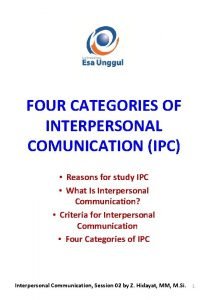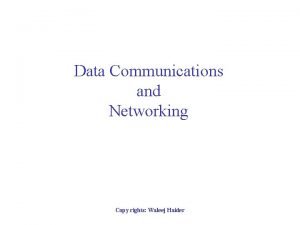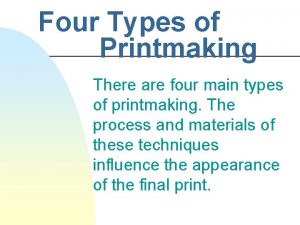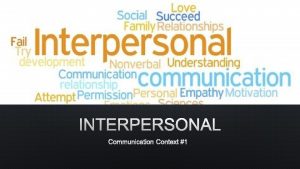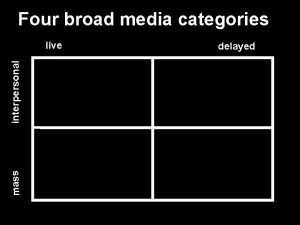FOUR CATEGORIES OF INTERPERSONAL COMUNICATION IPC Reasons for











- Slides: 11

FOUR CATEGORIES OF INTERPERSONAL COMUNICATION (IPC) • Reasons for study IPC • What Is Interpersonal Communication? • Criteria for Interpersonal Communication • Four Categories of IPC Interpersonal Communication, Session 02 by Z. Hidayat, MM, M. Si. 1

Reasons for study IPC • First, people create meaning through communication. • Second, IPC is important for practical reasons—we need to be able to talk to people in order to get things done and make positive impressions. • Third, IPC is important to us physically—people who have good interpersonal relationships are physically and mentally healthier. • Fourth, humans are social animals, and IPC helps us fulfill our social needs. • Finally, IPC research is important because how people think they communicate in relationships and how they actually communicate in relationships are very different. Interpersonal Communication, Session 02 by Z. Hidayat, MM, M. Si. 2

What Is Interpersonal Communication? • Researchers agree that IPC is communication that occurs between people in relationships. Criteria for Interpersonal Communication 1. Numerical—How many people are involved in the interaction? Two people is the classic number for IPC, but, depending on the situation and topic. 2. Channel—What medium is used for the communication? Face-to-face communication is the most immediate, but there are other channels, such as the telephone and e-mail, that allow partners to communicate in the moment. Interpersonal Communication, Session 02 by Z. Hidayat, MM, M. Si. 3

3. Feedback—The ability to adapt and respond to the other person enhances the communication and makes it more interpersonal. 4. Privacy—Is the interaction in public or private? Interactions that happen in front of many other people, or those that lots of other people are a part of, tend to be less intimate and have more superficial communication. 5. Goal—People are concerned about their own and the other’s identity, as well as the relationship, are more interpersonal. 6. Relationship type and stage—If the people in the relationship are interchangeable (e. g. , customer and clerk), the communication is less interpersonal. 7. Knowledge—The more we know about the other person and the better able we are to predict that person’s reactions, the more interpersonal the communication. 8. Mutual influence—Do one person’s actions influence the other’s subsequent actions? The more there is mutual influence, the more the communication is interpersonal. Interpersonal Communication, Session 02 by Z. Hidayat, MM, M. Si. 4

Four Categories of IPC • IPC theories fall into four categories: theories about meaning in relationships, theories about motives in relationships, theories about messages in relationships, and theories about movement in relationships. 1. Theories About Meaning in Relationships • Humans have created and live in a world of signs and symbols. The very relationships people need in their lives are developed and sustained though their use of symbols. • Constructivism is a theoretical framework that attempts to explain why people communicate the way they do and why some communicators are more successful than others. Interpersonal Communication, Session 02 by Z. Hidayat, MM, M. Si. 5

• Coordinated management of meaning theorizes that communication is a process through which people make sense of their world and produce a social reality. • Symbolic interactionism is a foundational sociological perspective that was influenced by many theorists, notably George Herbert Mead and Herbert Blumer. Though originally a sociological theory, symbolic interactionism is important in communication research. 2. Theories About Motives in Relationships • People have reasons for the way they behave. Operating off assumptions about others, interpretations of situations, and the desire to fulfill their own needs, people make choices about their communication. Interpersonal Communication, Session 02 by Z. Hidayat, MM, M. Si. 6

• Attribution theory provides a framework for understanding how individuals interpret their own and others’ behavior. According to attribution theorists such as Fritz Heider, people are motivated to make sense of behavior and explain patterns. • Fundamental interpersonal relationship orientation theory, introduced by William Schutz in 1958, argues that people are motivated to satisfy three needs: inclusion, control, and affection. People begin relationships to meet these needs. Inclusion is the need people feel to belong and be included. • Uncertainty reduction theory assumes that people want stable and predictable interactions, which lead people to reduce their uncertainty about others and events. Interpersonal Communication, Session 02 by Z. Hidayat, MM, M. Si. 7

3. Theories About Messages in Relationships • People have a variety of communication choices. Theories about messages in relationships attempt to explain why people say what they do during interaction and how they process messages. • Action assembly theory attempts to explain where our thoughts come from and how we translate those thoughts into verbal and nonverbal communication. John Greene, who first published this theory in 1984. • Comm. accommodation theory is interested in how and why people modify or change their communication behavior in different situations. This theory, developed by Howard Giles and colleagues in the 1960 s and 1970 s, explains the ways in which people influence and are influenced by each other while they are communicating. Interpersonal Communication, Session 02 by Z. Hidayat, MM, M. Si. 8

• Expectancy violation theory was proposed in the 1970 s by Judee Burgoon and colleagues. This theory argues that interpretations of a message are not simply about what is said or even how it is said. Instead, interpretation is determined by the situation, the other’s reward value (i. e. , the positive and negative characteristics of the person), and how the message meets or violates one’s expectations. • Politeness theory, published in the 1980 s by Penelope Brown and Stephen Levinson, argues that people will use different messages depending on their perception of the situation and the listener. Politeness is the way through which people attempt to lessen the potential threat in certain messages. This theory was strongly influenced by Erving Goffman’s notion of face, which is the positive social identity we claim for ourselves. • Speech act theory is about how people accomplish things with words. Developed during the 1960 s by John Austin and refined in the 1970 s by John Searle, this theory explains how people use language as action. Interpersonal Communication, Session 02 by Z. Hidayat, MM, M. Si. 9

4. Theories About Movement in Relationships • Relationships are always evolving. As people talk to each other and develop shared meanings, relationships are established, maintained, and sometimes even dissolved. Theories about movement in relationships describe how communication functions to move relationships along different trajectories. • Relational dialectics theory presents relationship change as the result of individuals’ navigating and negotiating their internal, contradictory desires. Relational dialectics theory, presented by Leslie Baxter and her colleagues, is rooted in the historical dialectic perspective of opposing but connected forces. • Social exchange theory offers the perspective that relationships are commodities and attributes movement in relationships to people’s desire to maximize their rewards while minimizing their costs (time or energy). This theory, founded by John Thibaut and Harold Kelley. Interpersonal Communication, Session 02 by Z. Hidayat, MM, M. Si. 10

• Social penetration theory, by Irving Altman and Dalmas Taylor, describes how selfdisclosure moves relationships from superficial to intimate. This was one of the first theories about how changes in communication patterns can effect changes in relationships. The theory, first published in the early 1970 s, is often called “the onion model” because it portrays people as having multiple layers centered on a core. • The relationship development model depicts relationship movement as a series of stages through which couples may move. In the 1980 s, Mark Knapp presented a 10 -stage model of relationships coming together and coming apart. Each stage is characterized by different communication patterns. Though movement through these stages is generally sequential and systematic, people may skip stages, stay in a stage, or repeat stages. Interpersonal Communication, Session 02 by Z. Hidayat, MM, M. Si. 11
 Interpersonal comunication
Interpersonal comunication Data communication components
Data communication components Common errors in communication
Common errors in communication Comunication examples
Comunication examples Nonviolent comunication
Nonviolent comunication Visual communication merits and demerits
Visual communication merits and demerits Power line comunication
Power line comunication In the tiff between scout and calpurnia
In the tiff between scout and calpurnia The four major categories of tissues are
The four major categories of tissues are Introduction to service marketing
Introduction to service marketing Explain the importance of noncompeting labor grades
Explain the importance of noncompeting labor grades What are the different types of printmaking
What are the different types of printmaking
